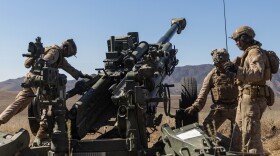The Navy is trying to figure out what the "new normal" will be after two years of battling COVID-19.
In the opening months of the pandemic, the Navy was caught off guard. In April 2020, it was forced to sideline the San Diego-based USS Roosevelt in Guam for over a month to stop a quickly spreading COVID-19 outbreak. Eventually, over a third of the sailors were infected.
RELATED: San Diego sailor has one of the worst cases of COVID in the Navy
One sailor on the carrier died. The Navy relieved the commanding officer, Capt. Brett Crozier, after a letter leaked where the captain complained that the Navy wasn’t doing enough to get sailors off the ship.
The situation became a case study on how not to handle COVID-19.
“The Roosevelt was made much worse largely by self-inflicted wounds by the Navy so that needs to change,” said Brad Martin, a retired Navy captain, who spent 30 years mainly on board surface ships. He is now a researcher with Rand Corporation.
RELATED: Free N95 masks are arriving at pharmacies and grocery stores. Here's how to get yours
Martin said the Navy underestimated the risk of COVID-19 and was slow to react.
“They were befuddled because they were getting a lot of conflicted guidance,” Martin said. “They were befuddled because the medical chain of command was telling people one thing, the operational chain of command was telling him something else.”
Fast forward to early January — the aircraft carrier USS Lincoln was about to depart from San Diego.
Sailors are required to wear masks now. Everyone on board is vaccinated. Many of the sailors volunteered to receive boosters of the vaccine. The head of the strike group, Rear Adm. J.T. Anderson, assured reporters the Navy now has its act together.
“Quite frankly, we’ve learned a lot over the course of the last couple of years. We feel we are in a good place because we are highly vaccinated,” Anderson said.
But the Navy has eased up on some of the restrictions that were put in place after the Roosevelt outbreak. Gone are the two weeks of isolation prior to boarding ships. And the admiral announced that the crew of 3,000 included sailors with active COVID-19 cases.
“We do have some positive cases within the carrier strike group, but again we’re extremely confident that we can safely and effectively execute our mission,” he said.
The Navy has a 98% vaccination rate, but thousands of sailors have applied for exemptions.
So far the Navy hasn’t granted any religious exemptions, though a federal judge has blocked the Navy from taking action against 35 SEALs who are suing on religious grounds.
“The Navy needs to think seriously about what's really a definite must do deployment and what's something that can wait, creating all sorts of havoc to meet a commitment may not be necessary.”Brad Martin, retired Navy captain and current researcher with Rand Corporation
Meanwhile for the first time in at least a decade, the Marines did recently grant a handful, without listing a reason.
“The way we deal with it now is more of an endemic than a pandemic,” said Vice Admiral Roy Kitchener. “For me personally, I think it’s going to be with us for the next few years, maybe forever. I don’t know.”
No one will deploy without being vaccinated. Ships are doing contact-tracing on board. And mirroring the Center For Disease Control guidelines, sick sailors spend five days in isolation, instead of 10 days, said Kitchener, during a media roundtable in early January.
“There is no magic to getting them out quicker,” Kitchener said. “There’s just more tools to manage it. That’s really the key thing we look at. Do we have enough people that can operate that ship safely?”
Martin wrote a paper on how the Navy handled the outbreak on board the USS Roosevelt.
He concludes the Navy has made progress keeping sailors healthy. Still, a lot of effort went into keeping ships at sea. Maybe a better answer was keeping ships home — rather than sending them on non-essential missions, according to Martin.
“The Navy needs to think seriously about what's really a definite must do deployment and what's something that can wait, creating all sorts of havoc to meet a commitment may not be necessary,” Martin said.
And Martin thinks the Navy still has trouble anticipating a crisis, instead of learning from its failures.






